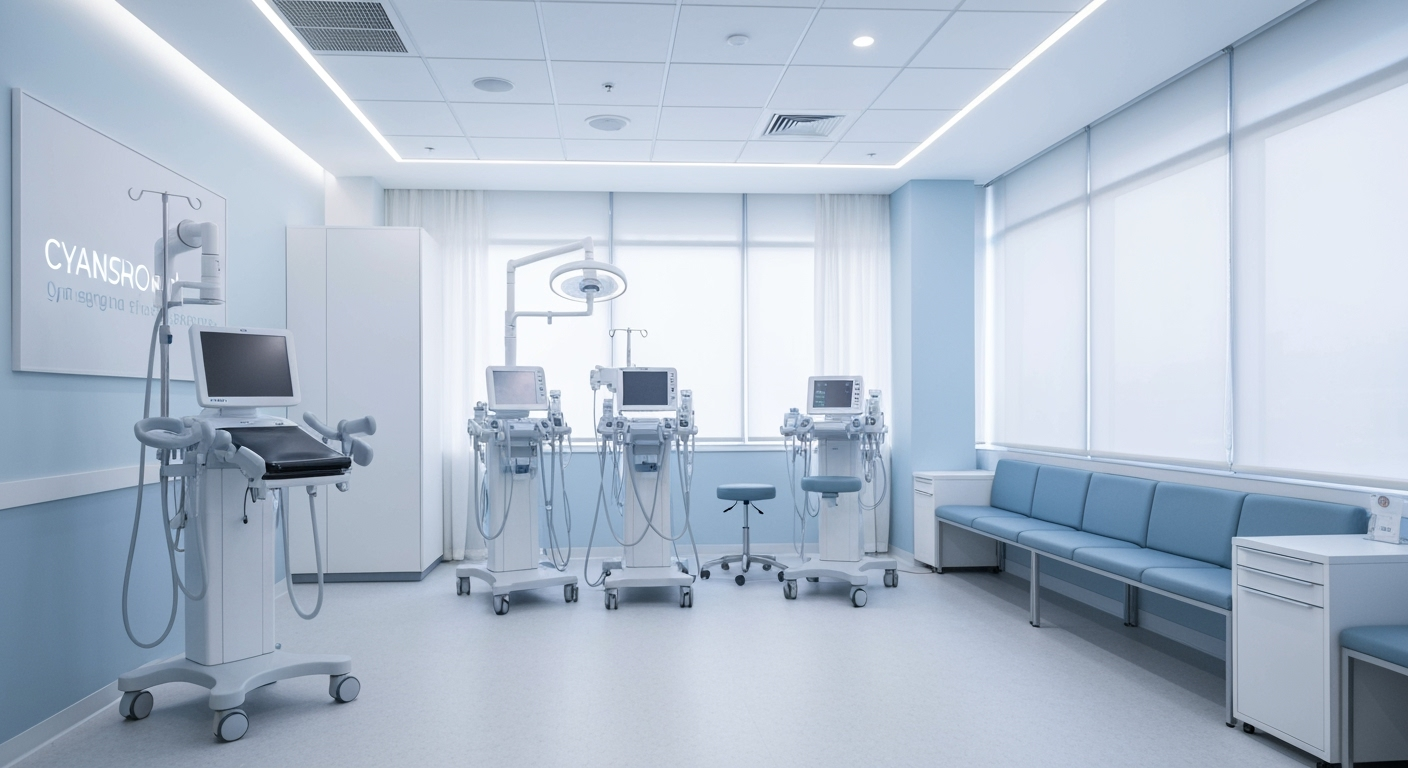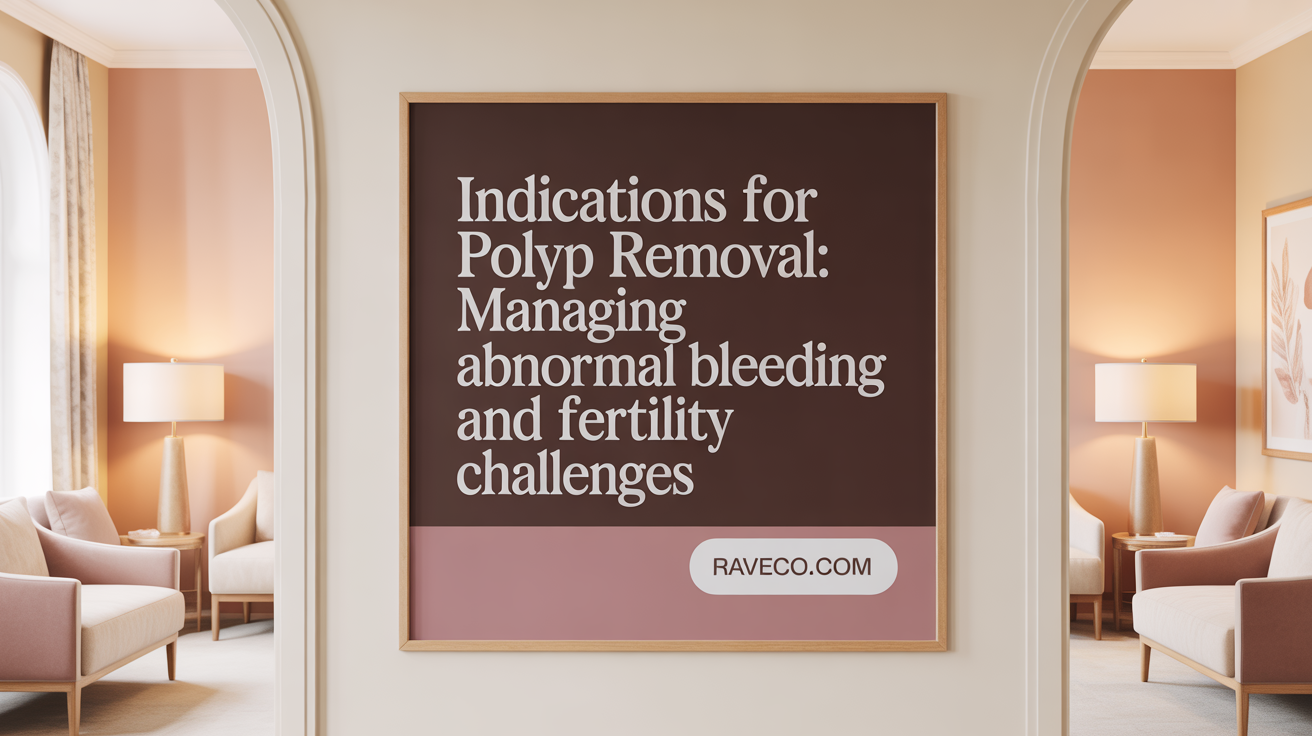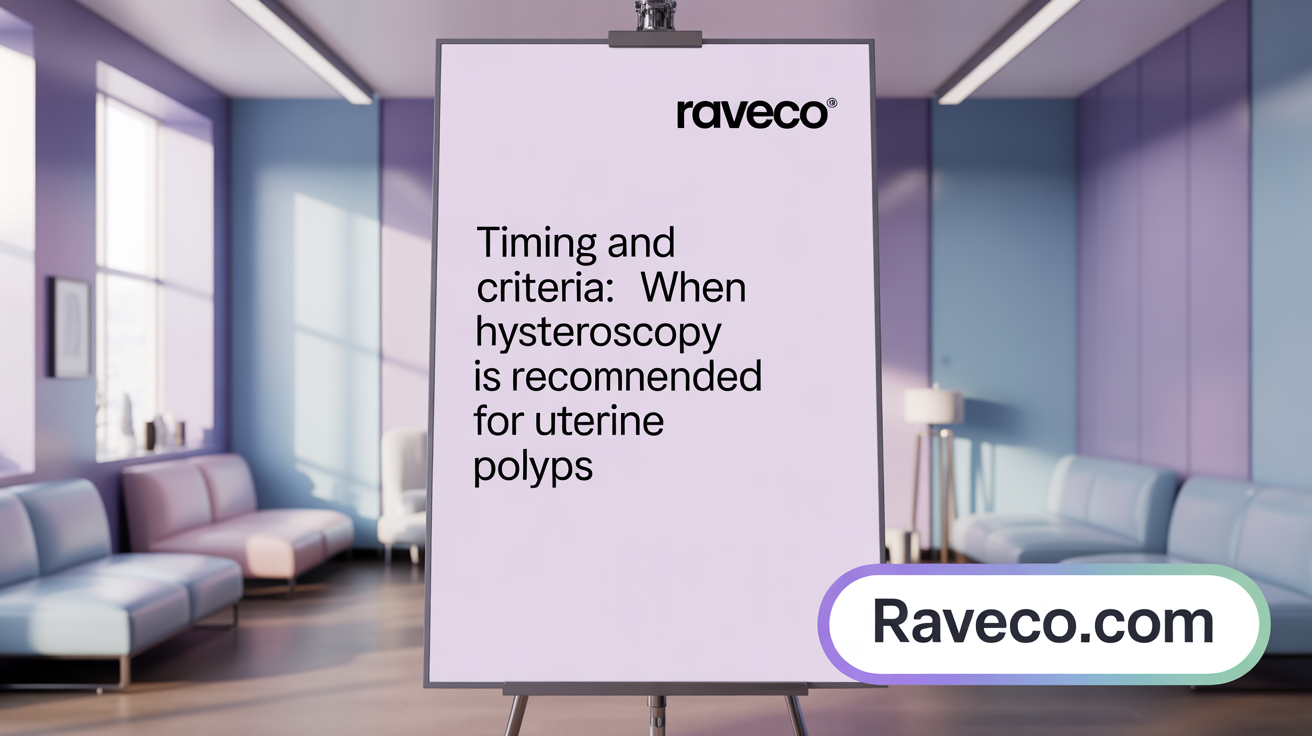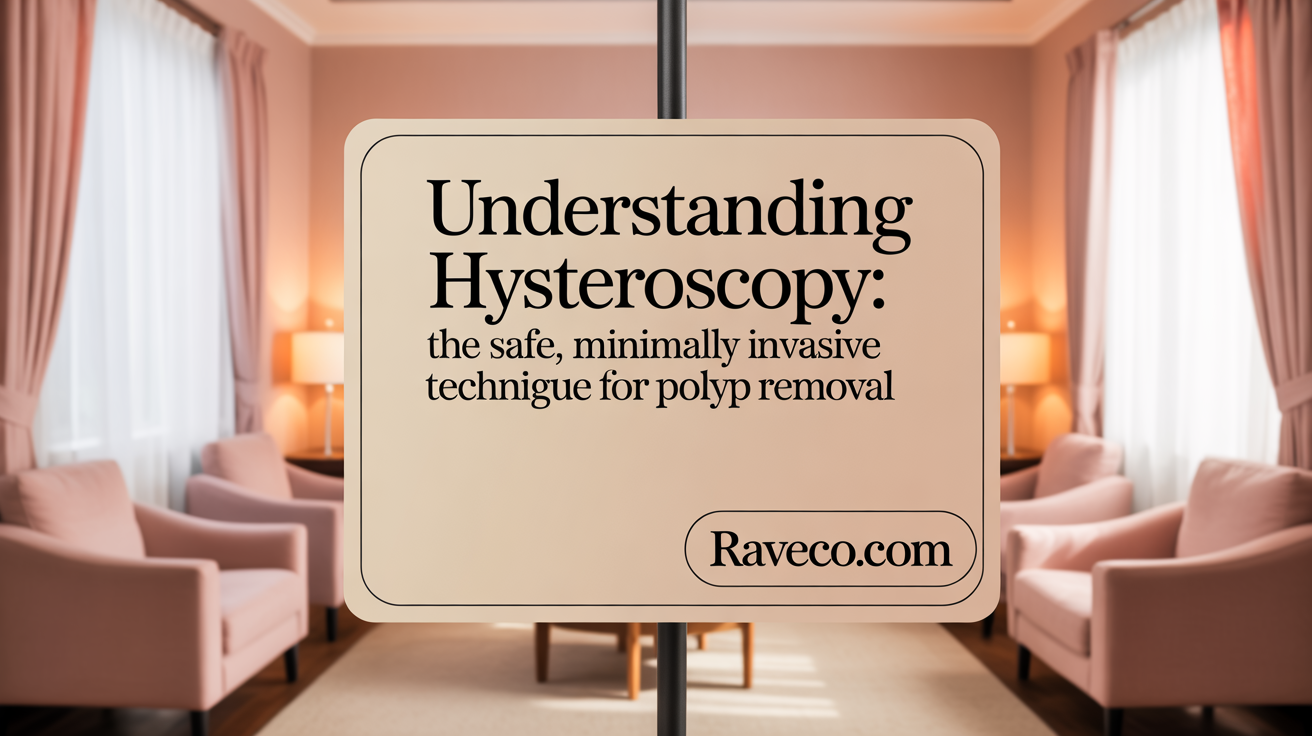Recognizing the Right Time to Address Female Infertility: Key Indicators and Expert Care in Queens

Introduction to Hysteroscopy and Uterine Polyps
Uterine polyps, benign growths on the lining of the uterus, can cause a range of symptoms including abnormal bleeding, infertility, and pregnancy complications. Hysteroscopy has become the gold standard for both diagnosing and treating these intrauterine conditions. This article explores when and why hysteroscopy should be considered for polyp removal, outlining the medical indications, timing, procedure details, and recovery aspects to help patients and healthcare providers make informed decisions.
Medical Indications for Hysteroscopic Polypectomy

What are the indications for hysteroscopy polypectomy?
Hysteroscopic polypectomy is primarily indicated when uterine polyps cause symptoms or pose risks that warrant removal. It is typically performed for women experiencing abnormal uterine bleeding, such as heavy menstrual bleeding, bleeding between periods, or postmenopausal bleeding. Fertility issues, including recurrent pregnancy loss or difficulty conceiving, are also common indications for removal of polyps that may interfere with implantation.
The procedure is essential when endometrial polyps are suspected to contain premalignant or malignant tissue, as histological examination is required to rule out cancerous changes. Hysteroscopy allows direct visualization of the uterine cavity, enabling precise removal of suspected polyps.
Non-invasive imaging methods like ultrasound or hysterosonography can suggest the presence of polyps, making hysteroscopy a valuable next step for confirmation and treatment. Overall, hysteroscopic polypectomy aims to improve reproductive outcomes, resolve abnormal bleeding, and obtain diagnostic tissue samples.
Symptoms and diagnostic signs suggest the need for hysteroscopic intervention in uterine polyps
Symptoms that often lead to hysteroscopic evaluation include abnormal bleeding patterns—such as heavy periods, irregular spotting, or bleeding after menopause—that raise suspicion of intrauterine pathology.
Women facing unexplained infertility or recurrent miscarriages are frequently evaluated with hysteroscopy to identify and remove polyps or other intrauterine abnormalities affecting conception.
Diagnostic signs from imaging studies like pelvic ultrasounds or hysterosalpingography can reveal intrauterine masses or irregular endometrial surfaces indicative of polyps. These findings, combined with clinical symptoms, justify further hysteroscopic assessment.
Other signs include retention of pregnancy tissue, incomplete miscarriage, or abnormal endometrial thickening seen on imaging, which may signal the need for direct visualization and removal of polyps.
In summary, abnormal bleeding patterns, fertility challenges, and imaging indications collectively guide the decision for hysteroscopic intervention to manage uterine polyps effectively.
When to Consider Hysteroscopy for Uterine Polyp Management
 Hysteroscopy is a preferred method for diagnosing and removing uterine polyps, especially when specific criteria are met. It is considered the gold standard for assessing intrauterine pathology, including polyps that cause symptoms.
Hysteroscopy is a preferred method for diagnosing and removing uterine polyps, especially when specific criteria are met. It is considered the gold standard for assessing intrauterine pathology, including polyps that cause symptoms.
When should hysteroscopy be considered for the management of uterine polyps?
Hysteroscopic removal is recommended when polyps are symptomatic, such as causing abnormal uterine bleeding, irregular periods, or heavy menstrual flow. Women experiencing postmenopausal bleeding often benefit from hysteroscopy to evaluate potential underlying issues, including malignancy.
It is also especially useful for women facing fertility challenges. Polyps can interfere with implantation or pregnancy, so removal via hysteroscopy can improve fertility outcomes.
In cases where there is suspicion of cancer or precancerous changes, hysteroscopy allows for targeted removal and biopsies, aiding in accurate diagnosis.
What are the criteria for deciding on hysteroscopic removal?
The size and location of the polyp play crucial roles. Polyps larger than 2 centimeters generally require a standard resectoscope procedure under general anesthesia, while smaller ones (less than 2 cm) can often be removed with office mini-hysteroscopy.
Lesion characteristics, patient health, and preferences also influence timing. For example, scheduling is optimal just after menstruation ends and before ovulation, especially in women with regular cycles. Preparing the cervix with medications like misoprostol can facilitate easier removal and reduce pain.
Risk factors influencing timing and approach
Certain risk factors, such as older age, obesity, hormone therapy, or suspicion of malignancy, warrant a more thorough evaluation and a potentially more aggressive approach. In women with irregular cycles or active bleeding, scheduling must be adjusted to optimize endometrial visualization.
Preoperative assessments, including ultrasound or biopsy, help determine the best timing and technique. In postmenopausal women, procedures are typically performed at any time since they are not influenced by cycle timing.
Patient groups especially indicated for hysteroscopy
Women who are experiencing abnormal bleeding, especially if postmenopausal or heavy bleeding in premenopausal women, are prime candidates. Women seeking to improve fertility by removing intrauterine abnormalities also benefit.
In women with risk factors for uterine malignancy or with certain findings on initial imaging, hysteroscopy provides definitive diagnosis and treatment.
| Patient Group | Indication | Additional Notes |
|---|---|---|
| Postmenopausal women | Heavy bleeding, bleeding after menopause | Can be performed anytime; high suspicion of cancer |
| Women with abnormal bleeding | Irregular or heavy periods | Timing after menstruation; helps rule out polyps |
| Fertility-seeking women | Recurrent pregnancy loss, infertility | Removal can improve implantation chances |
| High-risk women | Age, obesity, hormone therapy | Close monitoring and complete removal preferred |
This strategic approach ensures targeted treatment, minimizes risks, and enhances the likelihood of symptom resolution or diagnostic accuracy.
The Hysteroscopic Procedure for Polyp Removal: What Patients Should Know

Description of hysteroscopy technique
Hysteroscopy is a minimally invasive procedure that allows doctors to examine the inside of the uterus using a hysteroscope—a thin, flexible tube equipped with a light and camera. This thin instrument is inserted through the vagina and cervix, providing direct visualization of the uterine cavity on a monitor. The procedure often involves filling the uterus with a liquid or air to enhance visibility. It is typically performed without making external incisions, making it a safe and efficient way to diagnose and treat various intrauterine conditions.
Procedure steps and anesthesia options
Prior to the hysteroscopy, patients may receive medications to open the cervix, such as misoprostol, to facilitate instrument insertion. Depending on the extent of the procedure and patient preference, it can be done under local anesthesia, regional anesthesia, or conscious sedation, with most outpatient procedures using local anesthesia. During the operation, the physician guides the hysteroscope into the uterus, looks for abnormalities like polyps, and may use specialized tools through the hysteroscope to remove or treat lesions.
The procedure usually lasts between 10 to 30 minutes, making it a quick outpatient treatment option. Afterward, patients are monitored for a brief period before going home. Recovery is generally smooth, with most individuals returning to normal activities within a day or two.
Removal of polyps during hysteroscopy
A common reason for hysteroscopy is the removal of uterine polyps, which can cause abnormal bleeding. During the procedure, if a polyp is identified, the surgeon can excise or cut it away using small surgical tools passed through the hysteroscope. This helps resolve symptoms and also allows for tissue analysis to rule out cancer or precancerous changes.
After removal, the polyp is usually sent to a laboratory for histologic examination. Such removal is precise since surgeons have direct visualization, reducing the risk of incomplete excision. Most patients experience minimal discomfort and can often go home the same day.
Diagnostic biopsy and tissue analysis
Besides removal, hysteroscopy enables clinicians to take targeted biopsies from suspicious areas within the uterus. These tissue samples are sent for pathology testing to assess for benign, precancerous, or cancerous cells. This diagnostic capability is vital, especially in women experiencing abnormal bleeding or postmenopausal bleeding where malignancy risk is higher.
In cases of benign polyps, removal typically resolves symptoms and reduces the need for further invasive procedures. If tissue analysis indicates malignancy, additional treatment options will be discussed. Overall, hysteroscopy with tissue sampling is considered the gold standard for ensuring accurate diagnosis and effective treatment of intrauterine abnormalities.
Optimal Timing and Preparation for Hysteroscopic Polyp Removal

When is the best time to schedule a hysteroscopic polyp removal?
The ideal timing for the procedure is shortly after menstruation ends and before ovulation begins. This window ensures the uterine lining is thin, which provides a clearer view for the doctor, making it easier to locate and remove polyps accurately.
For women with irregular cycles, scheduling might require more flexibility or additional testing to determine the best timing when the uterus is less congested with blood or tissue. In postmenopausal women, the procedure can be performed at any time since menstruation has ceased.
How should I prepare for the procedure?
Preparation includes several important steps. Patients are usually advised to stop taking blood thinners days before surgery to reduce bleeding risks.
Medications such as misoprostol may be taken at least 4 hours prior to the procedure to help soften and open the cervix, especially beneficial for women with stiff cervices. Vaginal estrogen or other pre-treatments may also be used in postmenopausal women to facilitate easier dilation.
On the day of the procedure, patients should avoid douching, using tampons, or applying vaginal medicines for at least 24 hours beforehand. This helps minimize the risk of infection and interference with the procedure.
Patients are typically instructed to fast if general anesthesia is planned and to arrange transportation home afterward since sedation or anesthesia might impair their ability to drive or return to routine activities.
What assessment should be done before surgery?
Thorough assessment includes reviewing the patient's medical history, checking for allergies, and conducting a physical examination. Blood tests and ultrasound imaging may be ordered to evaluate the uterine size, polyp size, and to exclude pregnancy.
Important to note is verifying that pregnancy is reasonably excluded in women of reproductive age, as performing hysteroscopy during pregnancy can be risky.
Are there special considerations for postmenopausal women?
Postmenopausal women can undergo hysteroscopic polyp removal at any time, given that they no longer experience menstrual cycles. However, because the endometrial tissue may be thicker or abnormal, additional assessments like endometrial biopsy or ultrasound are often performed beforehand.
In some cases, pre-treatment with vaginal estrogen or other medications may be recommended to improve cervical dilation and reduce discomfort during the procedure.
Proper scheduling and preparation are crucial to ensure a safe, efficient, and comfortable experience, ultimately allowing for effective removal of polyps and minimizing risks.
Recovery After Hysteroscopic Polypectomy: Expectations and Care
What should a patient expect during recovery after hysteroscopic uterine polyp removal?
Most women find that they are mostly recovered within a few days following hysteroscopic polypectomy. Common post-procedure experiences include mild cramping, light vaginal bleeding or spotting, and slight discomfort. These symptoms are normal and typically resolve quickly.
Many patients are capable of resuming their usual activities within one to two days. However, internal healing continues for about two weeks, during which activity restrictions are recommended. Light bleeding or spotting may last up to 14 days, and menstruation usually returns to normal within four weeks.
Activity restrictions during recovery
To promote proper healing and reduce the risk of complications, patients should avoid strenuous exercise, heavy lifting, and sexual activity for approximately two weeks or until they receive clearance from their healthcare provider. It is advisable to stick to light activities and rest as needed during this period.
When to seek medical attention
Patients should be vigilant for symptoms that require prompt medical evaluation. Signs such as heavy vaginal bleeding, severe abdominal pain, fever, foul-smelling discharge, or any other concerning symptoms should prompt immediate contact with a healthcare professional.
Typical timeline for return to normal activities
Most women can return to work and normal routines within a day or two after the procedure. Full recovery, including complete internal healing, generally takes about two weeks. During this time, patients should follow their provider’s instructions, avoid risky activities, and attend follow-up appointments to ensure proper healing.
Understanding these recovery expectations can help patients manage their post-procedure period effectively and ensure a smooth return to everyday life.
Recurrence and Long-Term Considerations After Polyp Removal
Polyp recurrence rates after hysteroscopic removal are generally low, estimated at around 2.5 to 3.7%. However, the possibility of uterine polyps growing back remains, with regrowth typically occurring months to a few years after the initial procedure.
Several factors influence the likelihood and speed of polyp regrowth. Complete removal during the initial hysteroscopy reduces the chance of recurrence. Persistent hormonal imbalances, particularly elevated estrogen levels, can promote new polyp growth. Age and menopausal status also play roles; postmenopausal women tend to have a lower risk compared to premenopausal women.
Monitoring and follow-up care are important to detect any recurrence early. Regular gynecological examinations and imaging tests, such as ultrasound, can help identify new polyps. Managing hormonal factors through medical therapy or lifestyle changes may also decrease the risk. Patients should maintain communication with their healthcare providers and report any symptoms like abnormal bleeding or pelvic discomfort promptly.
In summary, while most women do not experience a recurrence, diligent follow-up and addressing hormonal influences are essential for long-term management. Early detection of regrowth allows for prompt treatment, preventing complications and improving overall uterine health.
Non-Surgical Approaches and Limitations in Uterine Polyp Management
Currently, there are no scientifically proven natural methods to effectively remove uterine polyps. While lifestyle changes such as adopting a healthy diet, supporting liver function to promote estrogen metabolism, managing inflammation, and reducing stress may help address underlying hormonal imbalances and inflammation that contribute to polyp formation, they do not directly eliminate existing polyps.
Small and asymptomatic polyps might sometimes regress on their own, especially if they are very tiny. However, larger or symptomatic growths typically require medical intervention. Surgical removal through hysteroscopy remains the most effective treatment, allowing precise removal and tissue analysis for potential precancerous or cancerous changes.
Decisions about managing uterine polyps often depend on symptoms, size, and the risk of malignancy. Observation might be appropriate for very small, benign polyps without symptoms, but it requires careful monitoring. If bleeding persists, or if there is a concern about cancer, intervention is usually recommended.
Women experiencing abnormal bleeding, fertility issues, or other related concerns should seek medical advice for proper diagnosis and tailored treatment options. Advances in minimally invasive procedures offer effective and safe options, favoring surgical removal as the standard in symptomatic cases.
Conclusion: Making Informed Decisions About Hysteroscopy for Polyps
Hysteroscopy stands as a pivotal procedure for the accurate diagnosis and treatment of uterine polyps. Recognizing the indications—including abnormal bleeding, infertility, and suspicion of malignancy—guides timely intervention. The procedure is minimally invasive, generally safe, and offers quick recovery, making it the preferred approach for removing problematic polyps. While recurrence is possible, ongoing follow-up helps manage long-term outcomes. Given the lack of effective natural removal methods, hysteroscopy remains central to managing uterine polyps that cause symptoms or carry health risks. Patients should collaborate with their healthcare providers to determine the optimal timing and approach for hysteroscopic treatment tailored to their individual needs.
References
- Hysteroscopy: Purpose, Procedure, Risks & Recovery
- Uterine polyps - Diagnosis & treatment - Mayo Clinic
- Endometrial Polyp Removal What to Expect | WakeMed
- Hysteroscopic Polypectomy and Dilation and Curettage (D&C)
- Uterine Polyps: Causes, Symptoms, Diagnosis & Treatment
- Hysteroscopy | Johns Hopkins Medicine
- Too big? A review of methods for removing large endometrial polyps ...
- Hysteroscopy: Before Your Procedure - MyHealth Alberta
- The Use of Hysteroscopy for the Diagnosis and Treatment of ... - ACOG





.png)